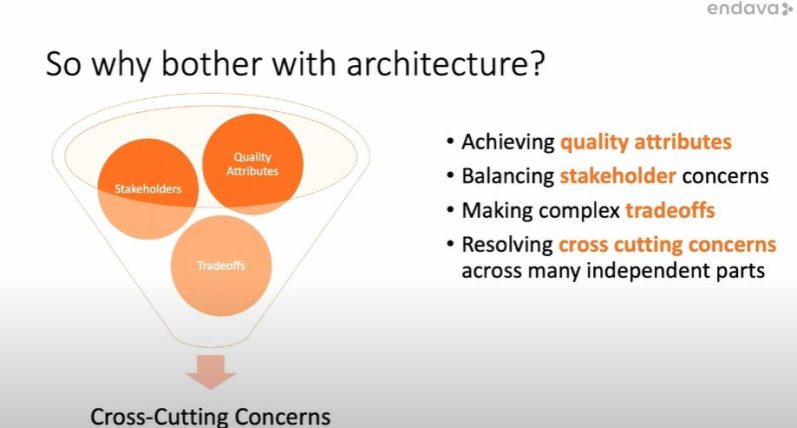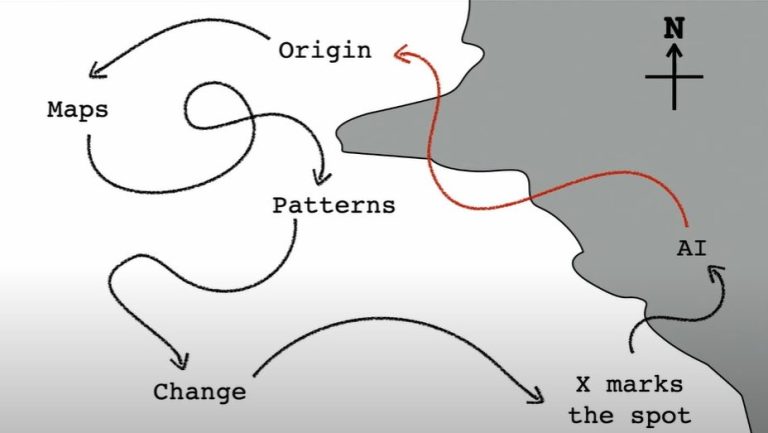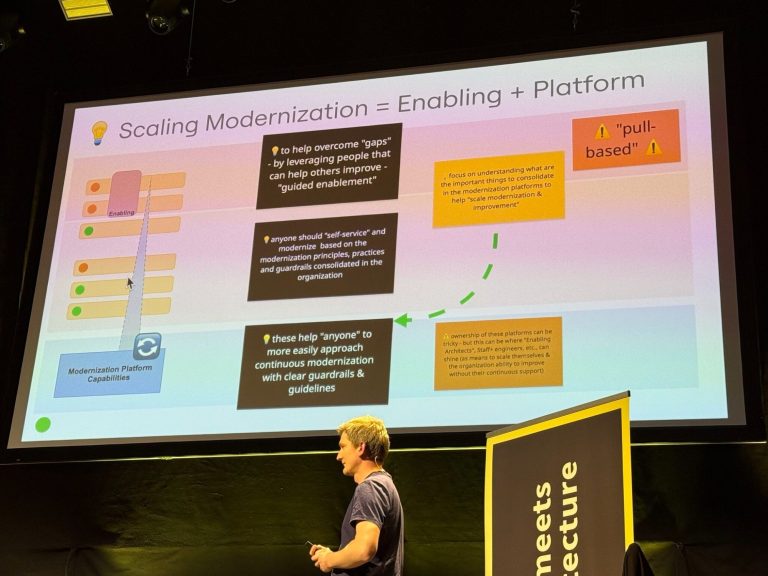Articles & Perspectives
A Collection of Reflections and Practical Insights - Where Knowledge Meets Real-World Practice
by Berrin Akvardar
Reflections on Agile Meets Architecture 2025: Insights from an Inspiring Conference
As an Agile Coach it is important for me to grow in my role and gain new knowledge from, whenever possible. Yes I have too much to tackle in my role at work and as a mother at home, but aren't we all in this world busy with different tasks, as multi tasking has become the new way of living. But I try to always make time to follow my passions and connect with the other Agilists to explore more. Because we are humans and without connections we are nothing but artificial constructs, like AI!

Eoin Woods' session on Practices for Effective Continuous Software Architecture provided actionable strategies for maintaining architectural integrity in an Agile environment. He explained why architecture matters, and the key practices that are needed to achieve Continuous Software Architecture. He also talked about the common architectural problems and how to overcome such cases. In his talk he started picturing the need and importance of architectural decisions and why it needs to be continuous, and not to be decided only in the beginning of each process or project.

He mentioned about the importance of making architectural decisions throughout the delivery as iterative, just like Agile way of working. Cause throughout the delivery, we are still learning and the things are continuously changing. Why not changing the architecture iteratively when needed, like he explained this in this picture, stop deciding the architecture in the beginning but do changes iteratively.
Conclusion
There were many more inspiring and engaging talks and also a Team Topologies Panel with Michael Plöd, Evelyn Van Kelle, Tsvetelina Plummer, Carola Lilienthal, Eduardo da Silva and Kenny Baas-Schwegler to discuss on how Team Topologies has been adopted so far for the questions like how well we distinguish between team types and team interaction modes in practice, and where did the problems arise in the application of Team Topologies.
What stood out to me was the collaborative spirit of the event. The conference wasn’t just about sharing knowledge; it was about fostering a community where ideas could be challenged, refined, and celebrated. From panel discussions to informal networking sessions, every interaction underscored the importance of bridging gaps—be it between disciplines, teams, or even individual mindsets.
As I reflect on my experience at Agile Meets Architecture 2025, I am struck by the richness of the discussions and the sense of community among attendees. I am grateful to have been a part of this journey and look forward to applying the insights I gained to my work and sharing them with my teams.

It was really fascinating how Simon Wardley used such real life examples, how he analysed the strategic decisions made by different cultures, and out of all these research he came up with the "Strategy Cycle" to make better strategical decisions in businesses. He explained this path via a Map and also showed how to use Wardley Mapping for better strategic and architectural decisions. A mind blowing story! The whole speech can be watched on Agile Meets Architecture YouTube Channel, From here to there and back again.
He talked about five factors that matter in competition: Purpose, Landscape, Climate, Doctrine and Leadership. He realized these factors as a pattern when reading the book "The Art of War"-Sun Tzu. And it was not only this book which proved these factors for to compete in life, but also real life examples, like US Air Force pilot John Boyd who also used this concept for strategic decisions.

This was one of the AHA moments I had at this conference, cause it made really sense. We always tend to decide on an architecture right in the beginning with lots of workshops and discussions, and document tons of architectural design like the holly grail of the system. We need to consider some change in such processes. More deep dive arguments on Continuous Software Architecture can be watched on Agile Meets Architecture YouTube Channel, Practices for Effective Continuous Software Architecture.
One of the insightful and thought-provoking talks at Agile Meets Architecture 2025 was Simon Rohrer's 4 Lenses on Organisation, who is one of the authors of Sooner Safer Happier. His discussion encouraged us to look beyond singular frameworks and embrace a multi-model approach to organizational design—one that balances efficiency, agility, and socio-technical concerns while delivering value to customers, stakeholders, and society.
What intrigued me most was his 3 states model—a powerful analogy using ice, liquid, and gas to represent varying degrees of coherence within an organization. It illustrated the dangers of both extreme rigidity (too much control) and excessive fluidity (lack of coherence), urging organizations to strive for balance.
Simon explained the 4 different models of an organisation through 4 lenses as the following:
Lens 1: Value Stream and Team Topologies – This model prioritizes faster delivery of customer value by eliminating silos and fostering multidisciplinary collaboration.
Lens 2: The Sooner Safer Happier model – This approach from Sooner Safer Happier, introduces a nested structure, ensuring alignment from individual teams up to entire business lines.
Lens 3: Viable Systems Model (VSM) – Originally conceived by Stafford Beer, the VSM provides a fractal perspective on organizations, mapping interactions across five different systems: operations, coordination, management, strategy, and identity.
Lens 4: Liquid Organisation Model – This model aims to strike a balance between working together (alignment) and working independently (autonomy) across all levels. It compares this to two other types of organisations: the "Frozen Organisation," which has too much structure and control but not enough independence, and the "Gaseous Organisation," which has too much freedom but lacks unity or clear direction.


Eduardo and Nick shared strategies for keeping the efforts for organizational modernization on track and accelerating progress while balancing technical, business, and organizational factors. They explained how enabling teams can play a key role in overcoming the resistance to change that often exists within organizations. These teams help make real progress toward modernization. They also explained how pull based approach is crucial through this process. This idea is very connected to the work we do with enabling teams.
Markus Harrer explored how software quality evolves throughout the product lifecycle in his talk, Evolutionary Software Quality. He emphasized the importance of adapting quality goals to match the current phase of development, whether it's creation, customization, or product maturity. Markus shared practical techniques for embedding quality incrementally, such as focusing on functional suitability during early stages and prioritizing security and maintainability as the product matures. His approach encourages teams to view quality as a dynamic target that evolves alongside the software, ensuring long-term success.
Cosima Laube's session Architecture in ACTion: Impactful Mind Skills for Tech Leaders was a deep dive into the human side of architecture. She introduced concepts like psychological flexibility and ACT (Acceptance and Commitment Therapy) to help tech leaders navigate complexity and uncertainty. Cosima provided practical tools for effective decision-making, conflict resolution, and strategic thinking, all while emphasizing the importance of empathy and communication. Her session highlighted how combining technical expertise with strong people skills can lead to impactful architectural outcomes.
Woody Zuill challenged the traditional reliance on estimates in software development in his talk Beyond Estimates (Estimates and "NoEstimates") - Let's Explore the Possibilities. He encouraged teams to evaluate whether estimates are truly necessary and explored alternative approaches to managing projects without them. His insights included interactive exercises to understand the limitations of estimates and practical strategies for focusing on delivering value rather than adhering to rigid timelines. His talk inspired to rethink how to approach planning and decision-making in Agile environments.
Eduardo da Silva, independent consultant and Team Topologies Valued Practitioner, and Nick Tune, principle consultant and author - Nick Tune, gave a really helpful talk on how to make architecture modernization more successful, In their talk theme Towards Effective Execution of Architecture Modernization they pointed out something important: the biggest problems and best chances for improvement don’t usually show up during the first workshop. Instead, you find them later when you dig deeper and start doing the actual work. This means it’s really important to make sure that modernization efforts don’t just stay as ideas from workshops that get forgotten when teams are pressured to focus on new features.
Jurgen Appelo's keynote Human Robot Agent: Scouting AI Beyond Hype and Doom addressed the transformative impact of AI on the workplace. He discussed how humans and machines can collaborate effectively, rather than competing, and explored the ethical considerations of AI-driven leadership. He introduced actionable framework for navigating complexity and fostering innovation in AI-enhanced environments, which he named as The Wicked Framework. His balanced perspective sparked meaningful conversations about the future of work and the role of technology in shaping it.
Yevgen Nebesov introduced the concept of sociotechnical systems in his talk Introduction to Sociotechnical Engineering, emphasizing the interplay between people and technical artifacts in software projects. He shared strategies for managing complexity by applying systems engineering principles to sociotechnical challenges. His approach included techniques for requirements analysis, system design, and troubleshooting, all adapted to the unique dynamics of sociotechnical systems. His talk underscored the importance of viewing software projects as holistic systems that evolve over time.
Earlier this month, 3-4 April 2025, I had the privilege of attending and speaking at the Agile Meets Architecture conference in Berlin, together with my dear colleague and friend Tsvetelina Plummer. We talked about how to Shift-Left learning to increase alignment an collaboration within the organization through Community Driven Learning in our talk Shift-Left for Learning - With the Help of Enabling Teams.
This event has become a beacon for professionals exploring the intersection of Agile methodologies and software architecture. Held at the vibrant Kulturbrauerei, the conference brought together a diverse group of thought leaders, practitioners, and innovators to share ideas, challenge norms, and inspire new ways of thinking.
It was a tremendous experience for me, not only attending the conference and listening to the talks, but also connecting with too many knowledge experts and having invaluable talks with them about Agility, Team Topologies, Architectural Designs, and many more. I have had too many AHA moments through these talks, and learnt so much which I will definitely use when working with my Agile teams. Speaking of, Simon Wardley's keynote, From here to there and back again, set the tone for the conference with his exploration of Wardley Maps as a tool for navigating the complexities of modern business. His engaging storytelling and practical examples left the audience with a deeper understanding of strategic decision-making, in order to address recurring business challenges.

©Copyright. All rights reserved.
Wir benötigen Ihre Zustimmung zum Laden der Übersetzungen
Wir nutzen einen Drittanbieter-Service, um den Inhalt der Website zu übersetzen, der möglicherweise Daten über Ihre Aktivitäten sammelt. Bitte überprüfen Sie die Details in der Datenschutzerklärung und akzeptieren Sie den Dienst, um die Übersetzungen zu sehen.
